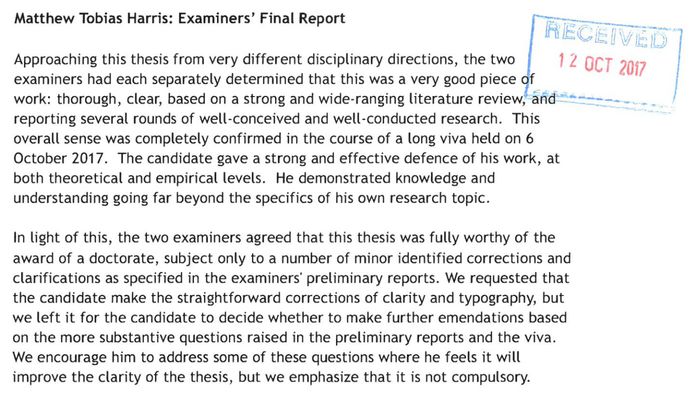the dissertation had done the talking, and the viva was good conversation about it wrapped up with a “dr. harris” handshake. phew, and woah. having been in a death-grip with the dissertation draft for so long, nothing in the whole experience could touch the wholesomeness of simply hearing “i read it all, and it’s good”.
supervisor –
Dear All,
I’m delighted to report that Toby Harris successfully defended his thesis "Liveness: An Interactional Account” this morning.
The external said: “that was a sheer pleasure”. (very) minor corrections.Pat.
–
Pat Healey,
Professor of Human Interaction,
Head of the Cognitive Science Research Group,
Queen Mary University of London
external examiner –
This is a richly intriguing study of the processes of interaction between performers, audiences and environments in stand-up comedy – a nice topic to choose since it is one where, even more than in straight theatrical contexts, ‘liveness’ is intuitively felt to be crucial. But as Matthew Harris says, what constitutes ‘liveness’ and how precisely it operates and matters, remains elusive – if pugnaciously clung to!
The conclusions reached and offered – which more than anything insist on the value and necessity of seeing all audience contexts as socially structured situations – both rings right, and seems to be based well in the details of the data presented. And the cautions at the end, about the risks with moving to higher levels of abstraction (wherein ‘the audience’ might become increasingly massified, rather than understood processually) looks good and valuable.
The specific claims made – that the ‘liveness’ of the performer matters little (e.g. by replacing him/her with a robot, or with a recording) – will nicely infuriate those with an over-investment in the concept, and will need careful presentation when this work is published. The subsequent experiment on the role of spotlighting or darkness on the kinds and levels of interaction audiences have with each other, and with the performer are also nicely counter-intuitive.
internal examiner –
I greatly enjoyed reading this thesis. It strikes a good balance between theory and experiment and makes several well-defined contributions. The literature reviews show a keen insight and a good synthesis of ideas, and the motivation for each of the experiments is made clear. The writing is polished and engaging, and the order of ideas in each chapter is easy to follow.


